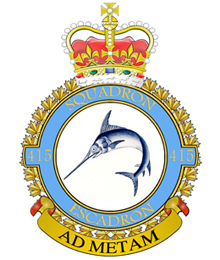The history of the Royal Canadian Air Force begins in 1914, with the formation of the Canadian Aviation Corps (CAC) that was attached to the Canadian Expeditionary Force during the First World War. It consisted of one aircraft that was never called into service. In 1918, a wing of two Canadian squadrons called the Canadian Air Force (CAF) was formed in England and attached to the Royal Air Force, but it also would never see wartime service. Postwar, an air militia also known as the Canadian Air Force was formed in Canada in 1920. In 1924 the CAF was renamed the Royal Canadian Air Force (RCAF) when it was granted the royal title by King George V. The RCAF existed as an independent service until 1968.
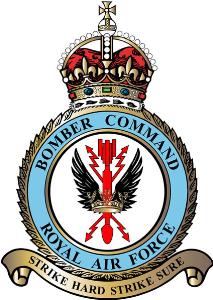
RAF Bomber Command controlled the Royal Air Force's bomber forces from 1936 to 1968. Along with the United States Army Air Forces, it played the central role in the strategic bombing of Germany in World War II. From 1942 onward, the British bombing campaign against Germany became less restrictive and increasingly targeted industrial sites and the civilian manpower base essential for German war production. In total 364,514 operational sorties were flown, 1,030,500 tons of bombs were dropped and 8,325 aircraft lost in action. Bomber Command crews also suffered a high casualty rate: 55,573 were killed out of a total of 125,000 aircrew, a 44.4% death rate. A further 8,403 men were wounded in action, and 9,838 became prisoners of war.

Royal Air Force Digby otherwise known as RAF Digby is a Royal Air Force station located near Scopwick and 11.6 mi (18.7 km) south east of Lincoln, in Lincolnshire, England. The station is home to the tri-service Joint Service Signals Organisation, part of the Joint Forces Intelligence Group of Joint Forces Command. Other units include the RAF Aerial Erector School, No. 54 Signals Unit and No. 591 Signals Unit.

The Handley Page HP.52 Hampden is a British twin-engine medium bomber that was operated by the Royal Air Force (RAF). It was part of the trio of large twin-engine bombers procured for the RAF, joining the Armstrong Whitworth Whitley and Vickers Wellington. The Hampden was powered by Bristol Pegasus radial engines but a variant known as the Handley Page Hereford had in-line Napier Daggers.

The Handley Page Halifax is a British Royal Air Force (RAF) four-engined heavy bomber of the Second World War. It was developed by Handley Page to the same specification as the contemporary twin-engine Avro Manchester.

Operation Stonewall was an Allied naval and air operation in the Second World War from 26 to 27 December 1943, to intercept blockade-runners sailing to German-occupied France through the Bay of Biscay. Operations Barrier and Freecar, by the Allied navies and the Brazilian Air Force, had taken place in the south- and mid-Atlantic. The ships were tracked by OP-20-G and British code-breakers, which decrypted Japanese machine cyphers and German Enigma machine transmissions to U-boats and blockade-runners.

419 Tactical Fighter Training Squadron is a unit of the Royal Canadian Air Force. The squadron was originally formed during the Second World War and is currently based at CFB Cold Lake. It is responsible for advanced tactical fighter training for pilots of the RCAF and as part of the NATO Flying Training in Canada (NFTC) program using nine CT-155 Hawk trainers.

No. 38 Squadron of the Royal Air Force was a bomber squadron formed in 1916 and was disbanded most recently in 1967.

No. 40 Squadron of the Royal Air Force was formed in 1916 at Gosport as No. 40 Squadron Royal Flying Corps and was disbanded for the last time in 1957. The squadron also included many non-British members, including volunteers from the Royal Australian Air Force and Royal Canadian Air Force.
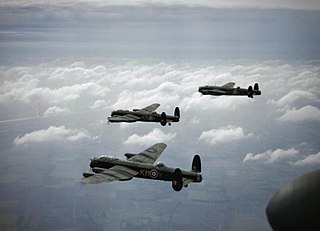
Number 44 (Rhodesia) Squadron was an aviation unit of the Royal Air Force. It was active between 1917 and 1982. For most of its history it served as a heavy bomber squadron.
No. 61 Squadron was a squadron of the Royal Air Force. It was first formed as a fighter squadron of the British Royal Flying Corps during the First World War. It was reformed in 1937 as a bomber squadron of the Royal Air Force and served in the Second World War and after, until disbanded in 1958.

No. 455 Squadron was a Royal Australian Air Force (RAAF) torpedo bomber squadron during World War II and became famous as part of the "ANZAC Strike Wing" that was formed from Australian and New Zealand squadrons. Raised in early 1941, mainly from Australian personnel, the squadron served over Europe during the war, operating from various bases in the United Kingdom; it also briefly sent a detachment to the Soviet Union in 1942. Operating Handley Page Hampdens and Bristol Beaufighters, the squadron mainly undertook anti-shipping and anti-submarine operations during the war. It was disbanded in May 1945 following the cessation of hostilities against Germany.

No. 428 Squadron RCAF, also known as 428 Bomber Squadron, and 428 Ghost Squadron, was first a night bomber squadron of the Royal Canadian Air Force engaged in strategic bombing during World War II, based in Yorkshire. At the end of the war the squadron moved to Nova Scotia before being disbanded in September 1945. In 1954 the squadron was reformed as 428 All-Weather (Fighter) Squadron, before being again disbanded in 1961.

426 Transport Training Squadron is a unit of the Canadian Forces under Royal Canadian Air Force, located at CFB Trenton in Trenton, Ontario. It originated as a squadron in the Royal Canadian Air Force (RCAF) that fought during the Second World War as a bomber squadron.
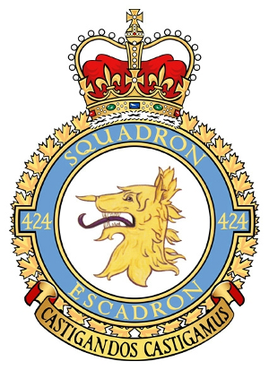
424 Transport and Rescue Squadron, nicknamed "Tiger Squadron", is a Royal Canadian Air Force strategic transport and search and rescue unit based at Canadian Forces Base (CFB) Trenton in the Canadian province of Ontario. The squadron is the primary provider of search and rescue response for the Trenton Search and Rescue Region, which extends from Quebec City to the Rocky Mountains, and from the Canada–United States border to the North Pole, covering an area of over ten million square kilometres in Central, Western, and Northern Canada.

Royal Air Force Thorney Island, or more simply RAF Thorney Island, is a former Royal Air Force station located on Thorney Island, West Sussex, England, 6.6 miles (10.6 km) west of Chichester and 7.1 miles (11.4 km) east of Portsmouth, Hampshire.
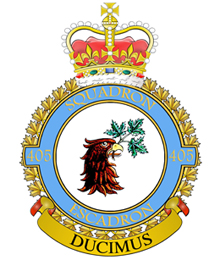
405 Long Range Patrol Squadron is a unit of the Royal Canadian Air Force (RCAF) within the Canadian Forces, initially formed as No. 405 Squadron RCAF during the Second World War.
No. 144 Squadron RAF was a squadron of the British Royal Air Force. It was first formed in 1918 during the First World War, operating as a bomber squadron in the Middle East. It reformed in 1937, serving in the bomber and anti-shipping roles during the Second World War. A third incarnation saw the squadron serving as a strategic missile squadron during the late 1950s and early 1960s.
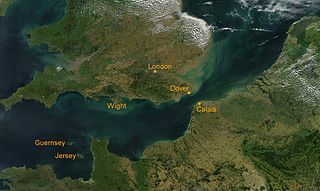
Unternehmen Donnerkeil was the codename for a German military operation of the Second World War. Donnerkeil was an air superiority operation in support of Operation Cerberus, also known as the Channel Dash by the Kriegsmarine.

The aircrews of RAF Bomber Command during World War II operated a fleet of bomber aircraft carried strategic bombing operations from September 1939 to May 1945, on behalf of the Allied powers. The crews were men from the United Kingdom, other Commonwealth countries, and occupied Europe, especially Poland, France, Czechoslovakia and Norway, as well as other foreign volunteers. While the majority of Bomber Command personnel were members of the RAF, many belonged to other air forces – especially the Royal Canadian Air Force (RCAF), Royal Australian Air Force (RAAF) and Royal New Zealand Air Force (RNZAF). Under Article XV of the 1939 Air Training Agreement, squadrons belonging officially to the RCAF, RAAF, and RNZAF were formed, equipped and financed by the RAF, for service in Europe. While it was intended that RCAF, RAAF, and RNZAF personnel would serve only with their respective "Article XV squadrons", in practice many were posted to units of the RAF or other air forces. Likewise many RAF personnel served in Article XV squadrons.
